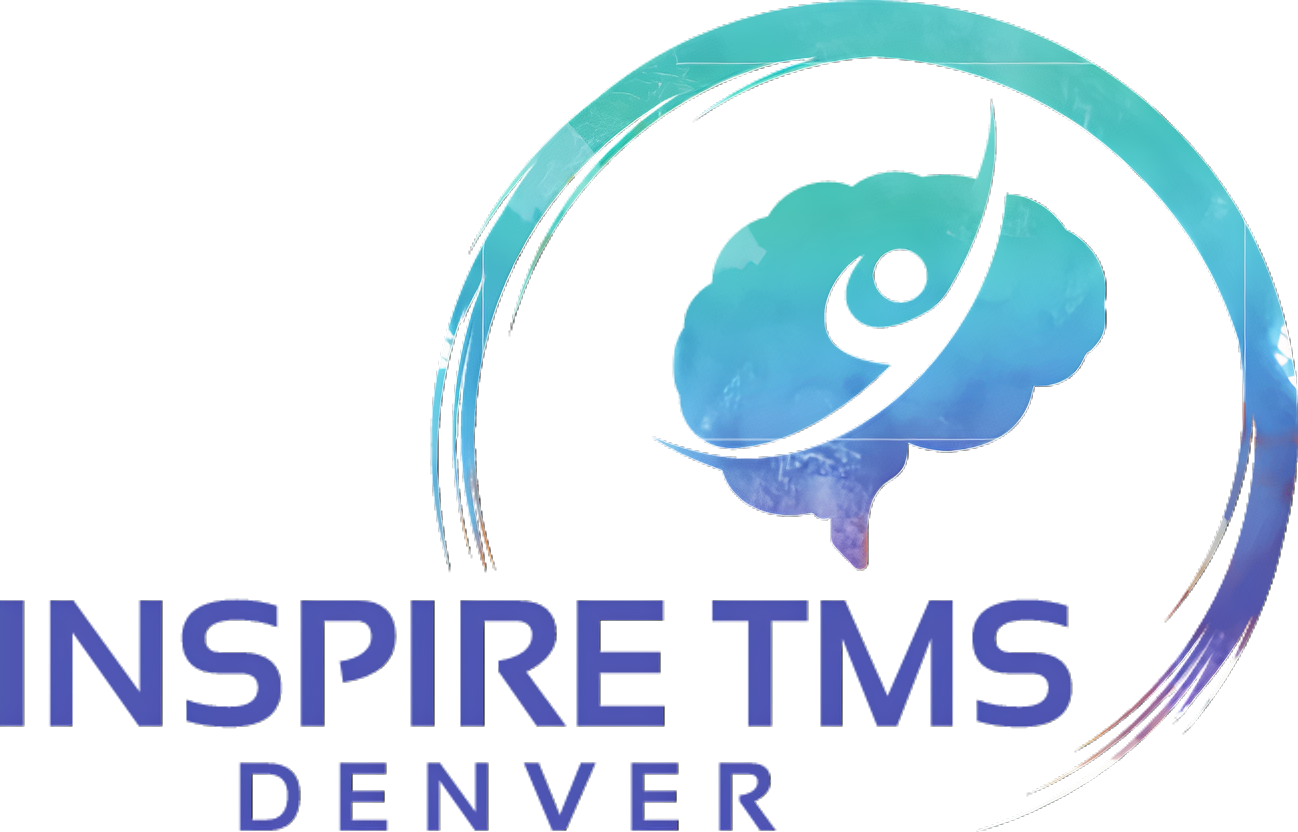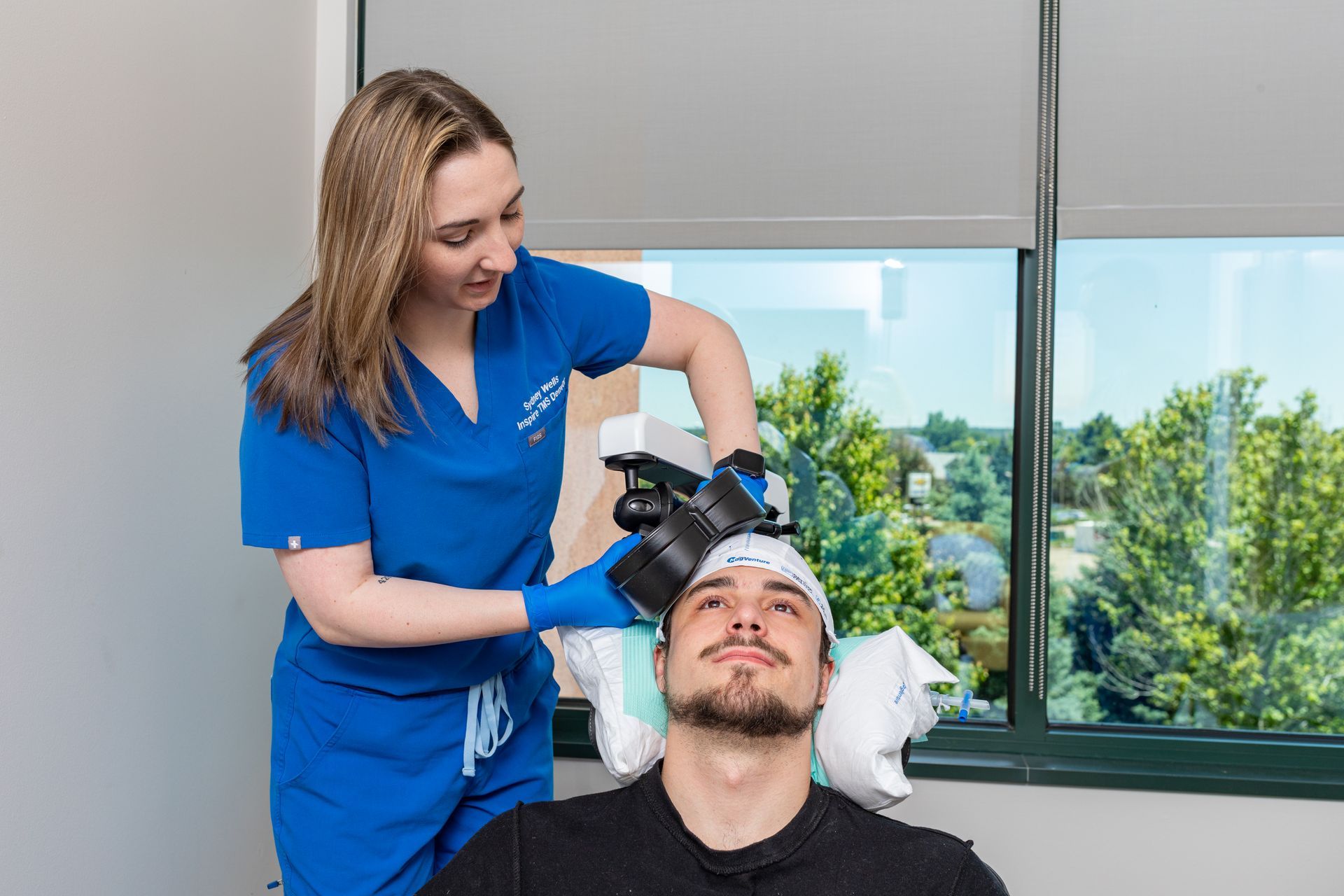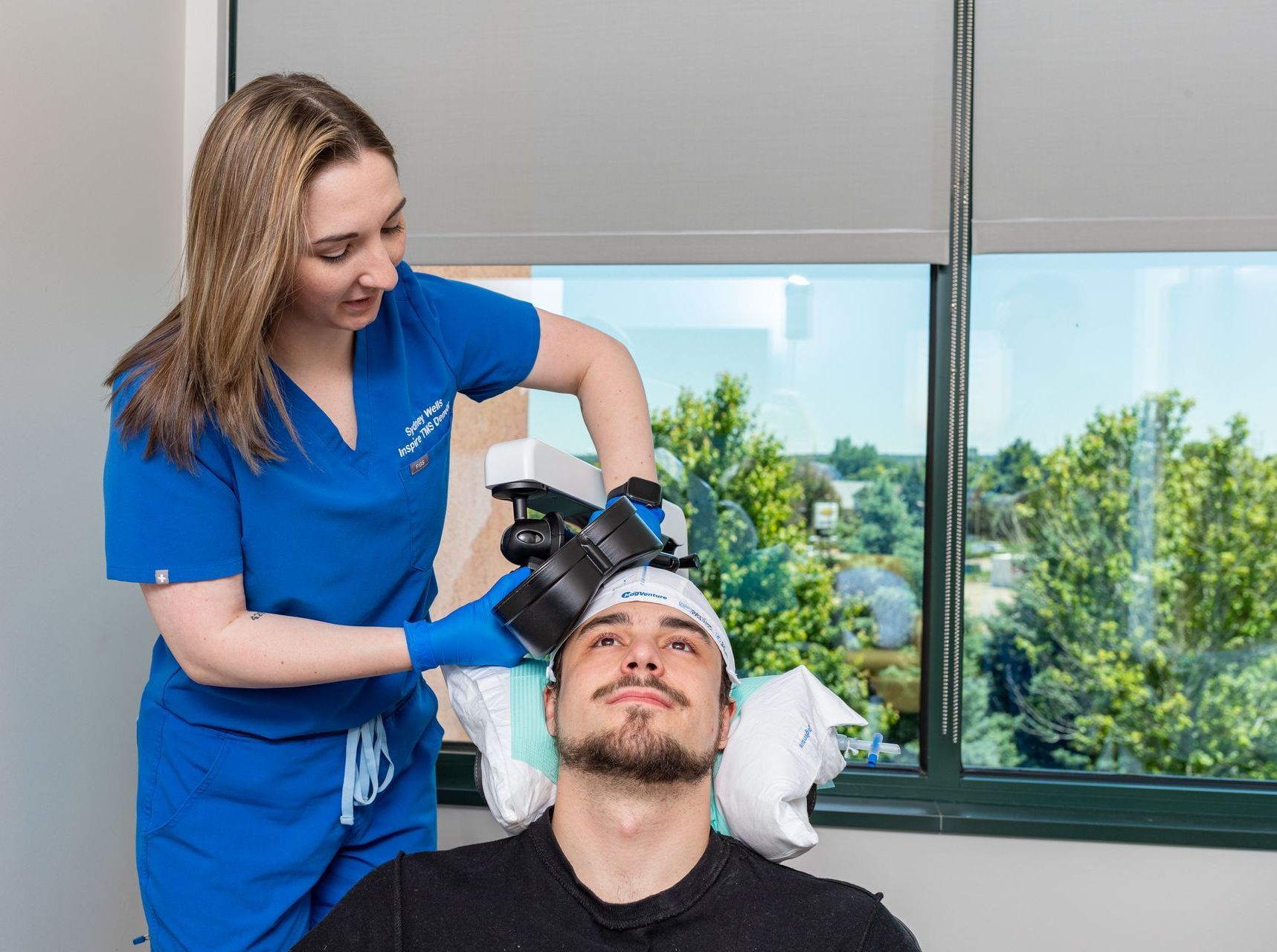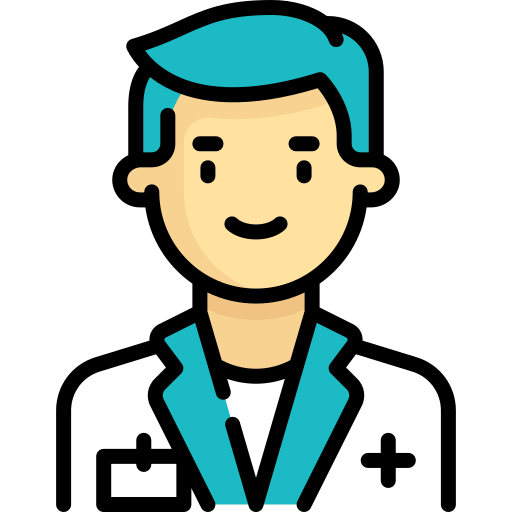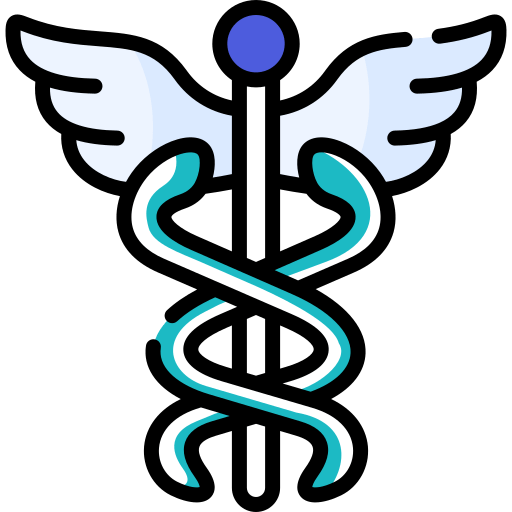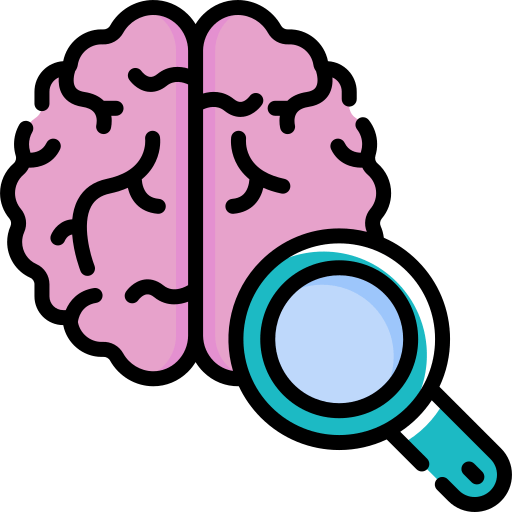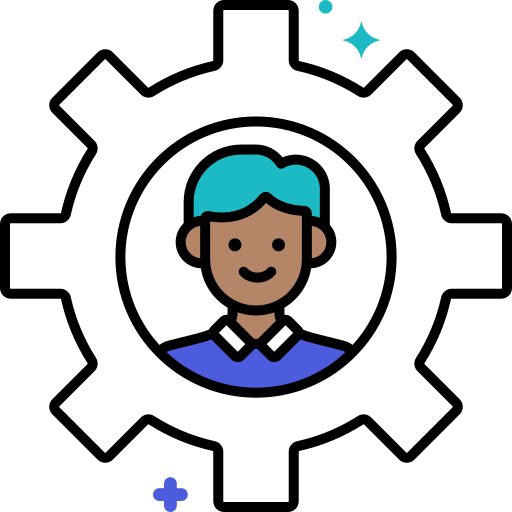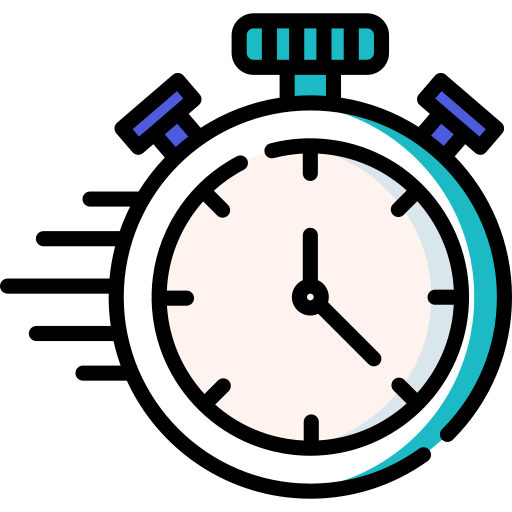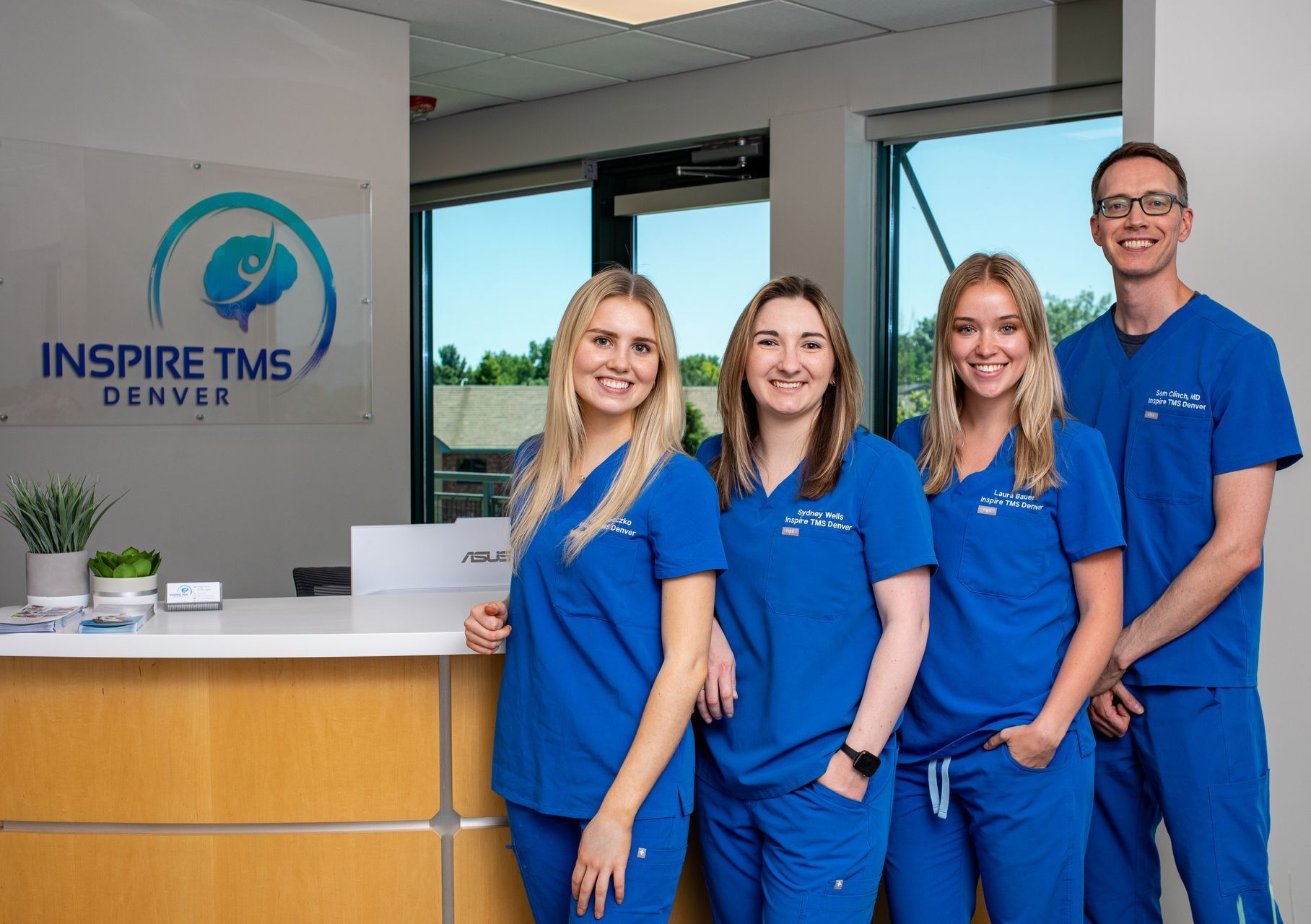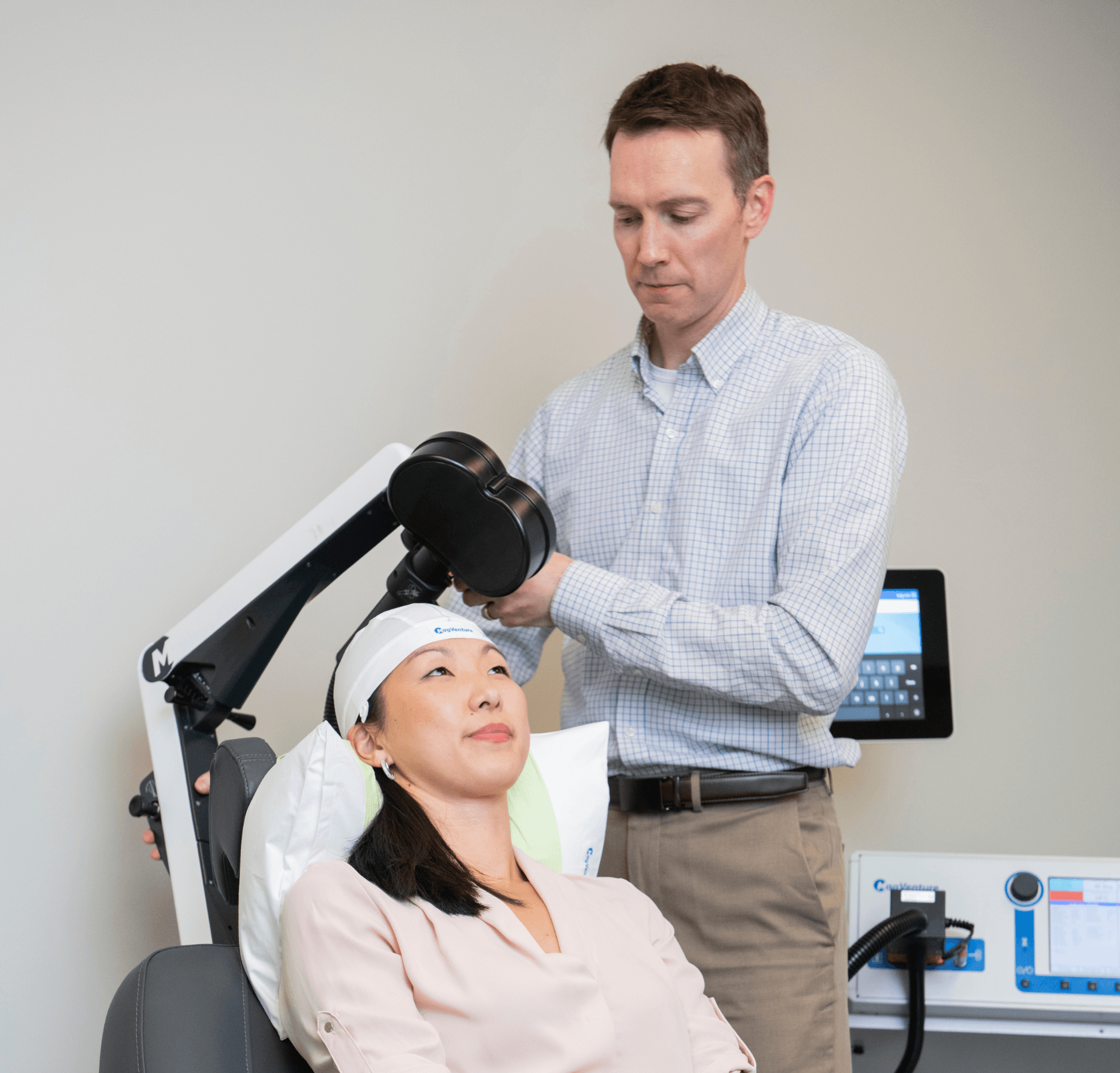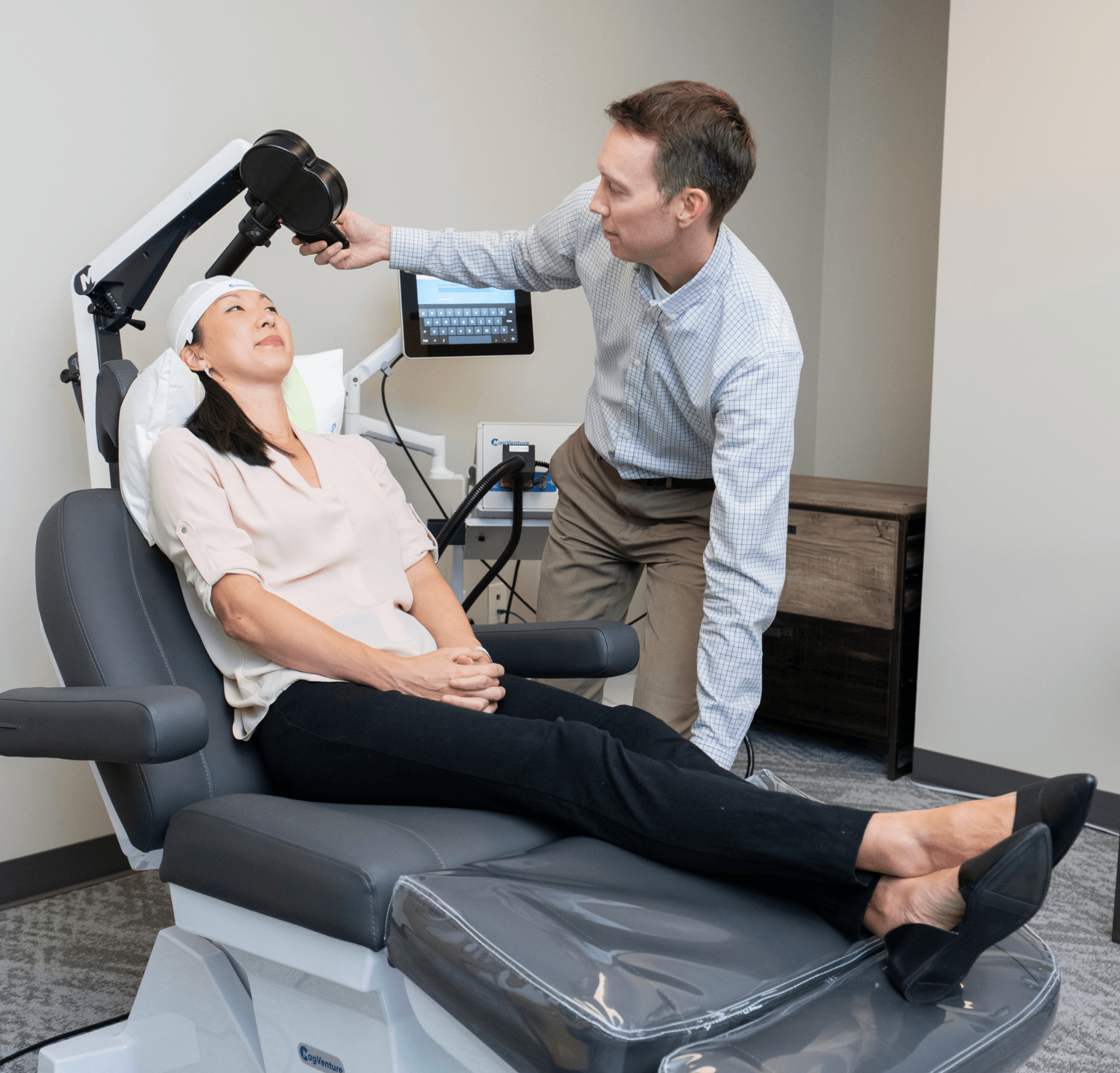LOCATION
340 East 1st Avenue, Suite 333 Broomfield, CO 80020
PHONE
720-446-8675
BUSINESS HOURS
- Mon - Fri
- -
- Sat - Sun
- Closed
Response Rates
10,000+ Treatments Completed
TMS Therapy For Depression
With TMS, we are re-calibrating broken neural pathways caused by depression and returning them to a healthier state conducive to mental well-being.
TMS Therapy For Depression
With TMS, we are in effect re-calibrating broken neural pathways caused by depression and returning them to a healthier state conducive to mental well-being.

With TMS, we are in effect re-calibrating broken neural pathways caused by depression and returning them to a healthier state conducive to mental well-being.
TMS Therapy For Depression
 Rating
Rating
Choose Recovery
Leading Depression Treatment In Denver, CO
If you are reading this page, it is fair to assume you are looking for an alternative depression treatment for yourself or a loved one. Thank you for researching Transcranial Magnetic Stimulation and we hope this page and website helps to educate and guide your decision process as you look for answers. Before we dive into TMS therapy, however, let’s talk a bit about Major Depression. What do we mean when we say Major Depression?
The human brain is a little like the universe, we are learning more and more about how it works, but much still remains uncharted territory. We know that emotions and mental well-being are rooted in the brain and involve billions of electrical connections in key circuits that all interconnect to function appropriately. We have started to map out the key structures within the brain and associated neural connections between them that regulate mood and emotions. But we still don’t know exactly how these all interconnect or how to make sure they work in synchrony. We are learning more each day, however.
Everyone at some point in their lives, regardless of location, lifestyle, age, gender, race, socioeconomic status, or other circumstance has traversed normal feelings of happiness and love. We also unfortunately all know frustration and sadness as well. Sadness is very different from depression, however, as it is only periodic and a normal response to some definitive cause - such as ending a relationship, saying goodbye to a loved one that passes, or even just tearing up watching a sad movie.
When sadness is persistent, however, and causes dysfunctional symptoms, Major Depression may be diagnosed. In this situation, depression often presents despite no major life event or stressor. Or if stressors are present, they serve as the catalyst for persistently low mood. A combination of bad luck through genetics and certain events at key times, can lead to depressed brain functioning. A very different picture is painted for the aforementioned connections in the brain. In depression, anxiety, and other mental health conditions, these connections work the opposite of intended and become stuck in negative feedback loops.
Read more: TMS therapy for anxiety →
Common Symptoms of Depression
In Major Depressive Disorder, these symptoms persist and the assistance of a mental health professional is needed. If safety concerns are present, resources such as the National Suicide Prevention Lifeline at 1-800-273-TALK (1-800-273-8255) or their web chat at suicidepreventionlifeline.org/chat are available. Additional crisis services are available through a mental health crisis walk-in center or the ER.
Treatments for Depression
Depression can range from mild to severe. Sometimes removal of a specific stressor or lifestyle change such as a healthy diet, exercise, or stopping alcohol or drug abuse can improve depression. When severe, however, willpower and changes in the environment will not pull someone from the black cloud that is severe depression.
Mild to Moderate Major Depressive Disorder may respond well to counseling such as Cognitive Behavioural Therapy - CBT. This can sometimes help manage more severe depression as well, but often only helps along with additional treatment. In this situation, antidepressant medications are utilized.
How Do Medications for Depression Work?
As noted, research into the pathophysiology of depression has shown changes occurring amongst different areas of the brain. We have also seen changes in brain chemistry, or neurotransmitters, that correlate to symptoms of depression. From a high level, we can see deficiencies in neurotransmitters such as serotonin and dopamine.
Antidepressants seek to rebalance these deficiencies by indirectly boosting the amount of these neurotransmitters circulating in the brain.
Unfortunately for many, however, antidepressants are not always effective short or long term. Treatment resistance and recurrence is common in up to 30% or more of patients with Major Depression.¹ With this knowledge, we must therefore presume that deficiencies in neurotransmitters are not the sole cause of Major Depression, nor do they fix the problem long term. With limited treatment options, however, patients and clinicians turn to medication after medication and combination of medications seeking relief. With each medication trial, however, we see diminishing returns and increased propensity for side effects.²
Read more: TMS vs medications →
What Can We Do When Medications Fail?
When therapy and medications fail, brain stimulation therapies such as Electroconvulsive Therapy-ECT, and Transcranial Magnetic Stimulation-TMS, can be highly successful in alleviating treatment resistant depression. Electroconvulsive therapy can be very effective, but is only used in severe or resistant mental disorders as it requires treatment with anesthesia, a surgical setting, and similar to medications, is limited by side effects.
Which finally brings us to TMS. The good news is that this novel treatment has shown great results, and carries no systemic side effects as seen with medication, nor other barriers to treatment or side effects seen with ECT. It is extremely safe and well-tolerated, can be conducted in an outpatient clinic, and shows better short and long term response and remission rates compared to multiple additional medication trials.³
Read more: TMS therapy success rate / TMS vs medications →
How Can TMS Help?
Transcranial Magnetic Stimulation, or TMS, is a relatively new approach to treating depression. It was FDA approved in 2008 and has recently been granted approval for other indications such as OCD and smoking cessation. Additional studies are underway for other often co-occurring mental health conditions such as Generalized Anxiety and PTSD and for other mood disorders such as Bipolar Depression. There are numerous other psychiatric and neurologic conditions that have also shown promise with TMS treatment.
Read more: TMS therapy for OCD →
As described above, we know that different pathways in the brain become dysfunctional in Major Depression. Medications tackle things from a broad approach by influencing neurotransmitter function throughout the brain - and unfortunately throughout the entire body as well. ECT is a bit more targeted as it causes a seizure in the brain, but this diffuse electrical discharge causes numerous effects throughout the brain and a convulsion. But what if we could be more targeted in our approach?
This is where TMS comes into play. By using a pulsating magnetic field at a targeted location known to be operating ineffectively in Major Depression, we are able to cause electrical discharge or potentiation of surrounding neurons. These in turn communicate with one another and influence connected brain circuits. Depending on treatment location and treatment protocol, this can awaken dormant depressed circuits or suppress hyperactive anxious pathways. With TMS, we are in effect re-calibrating broken neural pathways caused by depression and returning them to a healthier state conducive to mental well-being. And the latest TMS technology (iTBS - Theta Burst) imitates the brain's own natural process of electrical communication.
Read more: Theta Burst Stimulation →
Another way to perceive this, is that TMS gives the brain a guided ‘workout’. The magnetic pulses simulate brain patterns and the repetitive nature of treatment serves to build brain ‘muscle’.
TMS Therapy Process
TMS therapy with Inspire TMS Denver takes place as follows:
1
Congratulations, you have already taken the most important first step! You are learning about TMS and want to see if this treatment could be essential to relieving depression and associated mental health symptoms for yourself or a family member.
3
If you or a loved one are a good candidate, we will schedule a full evaluation with Dr. Clinch to review psychiatric history and determine the best course of TMS therapy.
4
After the evaluation, the team works with our billing department to ensure you get coverage for treatment through your insurance or that we know cost expectations if seeking self-pay. Read more:
TMS therapy cost
→
5
You come in for your first treatment with Dr. Clinch to complete a ‘mapping’ procedure. We determine the right stimulation intensity and location for treatment and you receive your first treatment after.
6
You return the next day for repeat treatment and Dr. Clinch and the team supervise all treatments following to ensure you are tolerating the procedures well and achieving intended relief. We periodically monitor depressive, anxiety, and other symptoms to track progress. You will likely receive a total of 36 treatments spaced out over 9 weeks. The first six weeks involve one treatment daily on the weekdays with a taper off treatment over the last three weeks.
7
A final visit takes place with Dr. Clinch to review the entire therapy course and we plan for follow-up to make sure you remain free from mental health symptoms. Read more:
How does TMS work?
→
Your TMS Consultation
An introductory consultation with Dr. Clinch will meet the following outcomes:
It will assist you in making a final decision about whether or not
TMS is the right treatment for you.
What is a Treatment Like?
As noted above, once you have completed your initial consultation and been determined a good fit for treatment, you will be prescribed the appropriate course of TMS therapy.
An initial ‘mapping’ session will take place where Dr. Clinch determines the best treatment stimulation intensity and location to cause electrical firing in your brain. You wear soft earplugs as a safety precaution as the stimulation emits a mild to moderate tapping noise. The first treatment takes place following the ‘mapping’.
You will be seated in a comfortable reclining chair and positioned so that your head remains in the same position throughout the treatment. The magnetic coil is then positioned at the treatment site, resting gently on your scalp. The treatment begins with repetitive stimulations at the treatment site with brief intervals that are stimulation free to allow for the neurons to fire and connect, return to baseline, and then fire and connect again. This is necessary to cause excitation of the surrounding hypoactive nerve cells. Repeated or constant stimulation actually can alternatively cause reduction or depression in activity. This approach can be utilized in certain situations where brain activity is hyperactive, such as anxiety.
The magnetic pulsations feel like a sharp tapping just surrounding the treatment site. The pulsations only directly influence neuronal activity two to three centimeters into the surrounding tissue. You hence only feel a pulsation in this diameter. Typically, this is well tolerated and we usually start with a lower target intensity and then gradually work up over the first week to avoid any discomfort. A mild headache or slight sensitivity at the treatment site are the most common side effects and these are usually mild and resolve after the first few sessions. Some patients have even fallen asleep during treatment as the pulsations can lull people to sleep. This is not a goal for treatment as we want the brain in a resting, but wakeful state, but it gives an idea as to how easy the treatment can be.
The treatment can take as little as three minutes with the newest Theta Burst stimulation or up to 19 minutes with the standard 10 Hz protocol. Treatment time may vary between this or be a bit more based on additional treatment sites and parameters. Once the initial mapping is complete and your unique parameters are entered into the system and our confidential electronic medical record, you may be able to get in and out of the office in 30 minutes or less.
Before, during, and after treatment there is no need for medications to tolerate the procedure. You may use an over-the-counter analgesic, but most find this unnecessary. You can drive to and from appointments without assistance. You may return to work and other daily activities following treatment.
Each treatment is reviewed by Dr. Clinch and your TMS therapist and progress is recorded securely in our electronic medical record. Treatment is reviewed throughout care and adjusted as needed. Remapping or changes to treatment protocol can be administered as necessary.
Read more: First visit expectations →
Why TMS?
Many people who suffer from depression and anxiety manage their condition very well through medication, therapy, and lifestyle modifications. Unfortunately, a large number of patients still struggle to find relief, however, and TMS has demonstrated excellent results with those individuals.

“My experience was remarkable. I will for ever be grateful to my doctor for referring me to Inspire TMS. I had been battling depression for many years with little to no relief from medication. I recently completed my treatment and it has been life changing. I finally know what is it like to not be depressed all the time and I finally have energy to do the things I had put on hold for many years. Friend and coworkers have commented on how lighter and brighter I look. Dr. Clinch, Sydney and Michelle, have been amazing since the beginning. Dr. Clinch took his time to explain everything about TMS on my consultation and was present for all treatment appointments even if it was just to do a quick check-in. Sydney and Michelle are kind and empathetic and provided a lot support during my treatment. Just like Dr. Clinch, they are very knowledgeable and I could feel they were invested in my well-being and made sure my treatment was comfortable.
I highly recommend Inspire TMS not only will get receive great treatment but will have an amazing team supporting you through out your treatment. Their office is very cozy and inviting. I was always seem promptly for all my appointments and whenever I needed to reschedule they were able to fit me in the same. I especially liked been able to communicate via text. There is nothing bad I can say about Inspire TMS. They certainly exceeded my expectations." - Ana L.
It also serves as a powerful alternative to antidepressants that frequently cause challenging side effects. In light of this, TMS is growing as an alternative and in many cases preferred next step for treatment. As a result, all insurance providers now cover TMS for Treatment-Resistant Depression and indications are growing. Inspire TMS Denver accepts all insurers and works with patients throughout treatment to ensure they understand costs. Self-pay is also an option when insurance doesn’t cover treatment.
Transcranial Magnetic Stimulation-TMS, is the only neuromodulation treatment that offers relief for Treatment Resistant Major Depression that is rapid and allows patients to return to their day immediately after therapy sessions. It is,
TMS Therapy For Depression at Inspire TMS Denver
We hope the information on this page and associated pages is helpful in determining if Transcranial Magnetic Stimulation might be the next best treatment option for you or a family member. TMS is a great and underutilized treatment option that is safe, well-tolerated, and highly successful at relieving depression and other mental health symptoms. Our team at Inspire TMS Denver will review all treatment options to ensure you are getting the best chance for success if you elect to pursue TMS therapy. More questions about TMS Therapy for Depression or other information on this page? Please contact us to see about a free phone consultation.
Free Consultation
What Happens After I Send My Message?
- A member of our team will confirm your free consultation appointment within one business day.
- Discover if TMS is right for you and answer all your queries about treatment, eligibility and costs.
Contact Us
We will get back to you as soon as possible.
Please try again later.


Slide title
Write your caption hereButton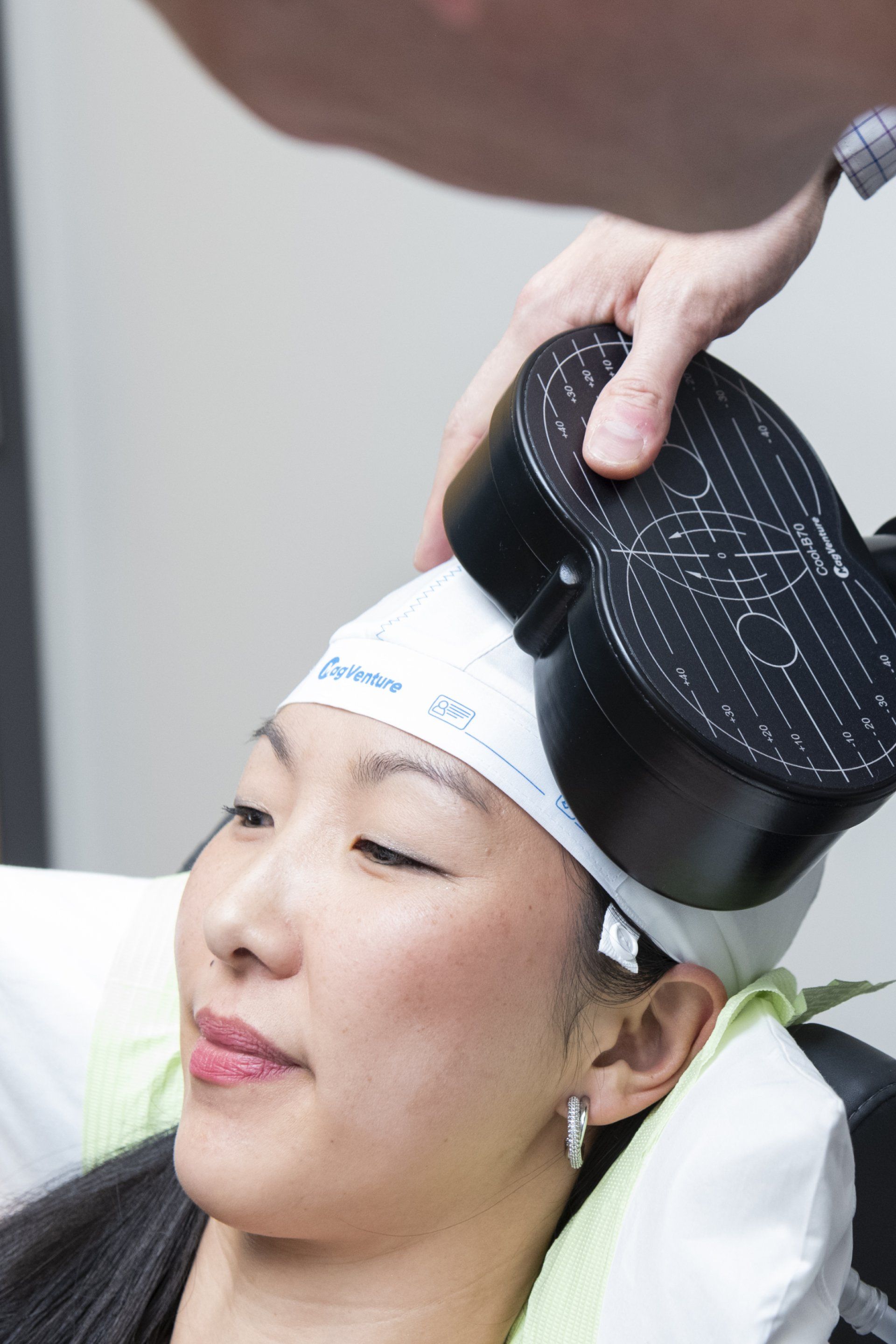
Slide title
Write your caption hereButton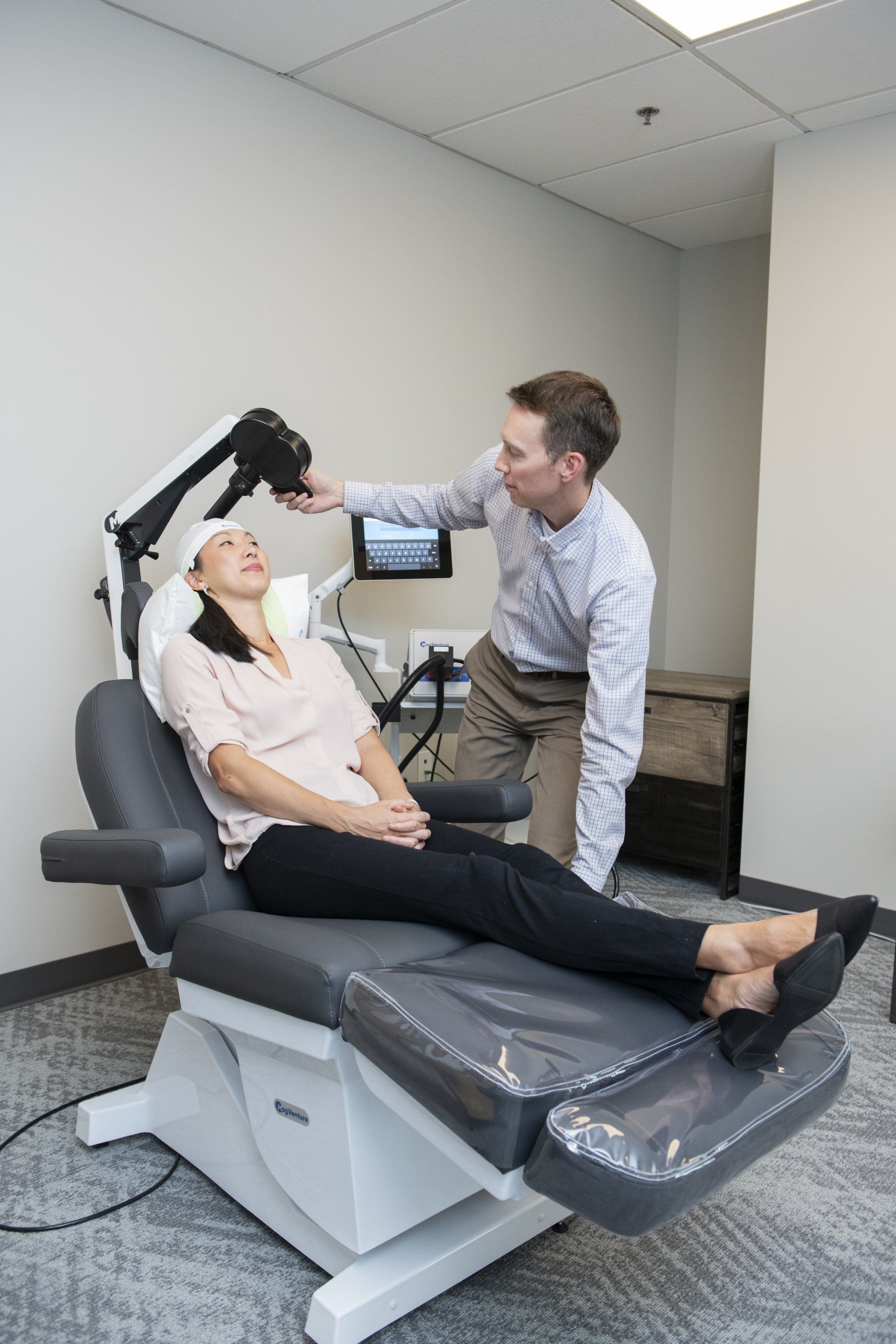
Slide title
Write your caption hereButton
What Makes Us Different
Free TMS Therapy Guides, Quizzes & Phone Consultations


As Seen On Colorado's Best
For more visit our video library →
Awards & Accreditations
This is a paragraph. Writing in paragraphs lets visitors find what they are looking for quickly and easily.
This is a paragraph. Writing in paragraphs lets visitors find what they are looking for quickly and easily.
This is a paragraph. Writing in paragraphs lets visitors find what they are looking for quickly and easily.
This is a paragraph. Writing in paragraphs lets visitors find what they are looking for quickly and easily.
This is a paragraph. Writing in paragraphs lets visitors find what they are looking for quickly and easily.
Company Name
the tms journey
A Step By Step Process

Book your free telephone consultation with Dr. Clinch and use this time to ask any questions or voice any concerns about TMS. If there are no contraindications to treatment, you are a good candidate, and you wish to proceed with a full evaluation, we will schedule a full intake. You will be sent an invite to our confidential patient portal and forms for review and completion that expedite care.
Shortly after this, you will be seen in person for the full TMS evaluation. This will provide adequate information for us to then submit prior authorization for TMS coverage to your insurer. If seeking care off-label through self-pay, prior authorization is not needed. We then schedule your first and all subsequent treatment sessions. We obtain prior authorization and inform you of all costs prior to starting care.
Come in for your first treatment which starts with a 'mapping' to establish your unique treatment intensity and location. Following this and at all subsequent sessions, you will recline in a motorized chair, similar to a dental visit. You can then relax, listen to music, watch TV, read or chat during the treatment. At the end of your sessions, you can drive and return to your day as normal.
Samuel B. Clinch, M.D
Medical Director
Our shared inspiration is to alleviate mental illness and improve the mental wellbeing of the patients we treat. We respect all backgrounds and cultures and want to hear our patient’s stories to best guide care. During treatment, we reinforce positive wellness practices, help maximize lifestyle modifications, and integrate rTMS therapy into a patient’s overall mental and physical health treatment.
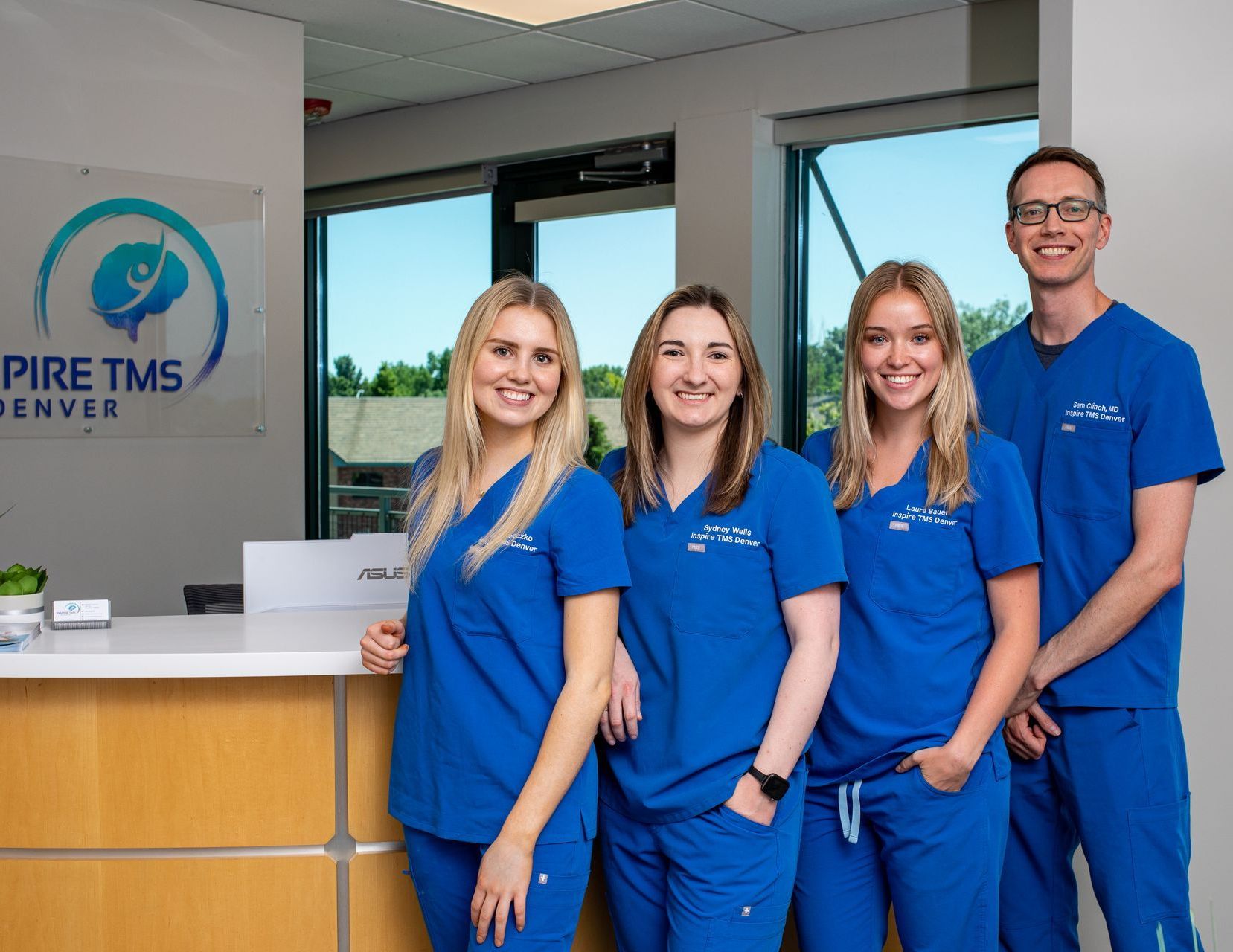

Free Consultation
Call 720-446-8675 now, or complete the form below to request a call back.
Contact Us
We will get back to you as soon as possible.
Please try again later.
Contact Us
LOCATION
340 East 1st Avenue, Suite 333
Broomfield, CO 80020
What Happens After I Send My Message?
A member of our team will confirm your free consultation appointment within one business day.
Discover if TMS is right for you and answer all your queries about treatment, eligibility and costs.
Take the First Step Towards Your Mental Well-being Today
Choose Recovery
Leading Depression Treatment In Denver, CO
If you are reading this page, it is fair to assume you are looking for an alternative depression treatment for yourself or a loved one. Thank you for researching Transcranial Magnetic Stimulation and we hope this page and website helps to educate and guide your decision process as you look for answers. Before we dive into TMS therapy, however, let’s talk a bit about Major Depression. What do we mean when we say Major Depression?
The human brain is a little like the universe, we are learning more and more about how it works, but much still remains uncharted territory. We know that emotions and mental well-being are rooted in the brain and involve billions of electrical connections in key circuits that all interconnect to function appropriately. We have started to map out the key structures within the brain and associated neural connections between them that regulate mood and emotions. But we still don’t know exactly how these all interconnect or how to make sure they work in synchrony. We are learning more each day, however.
Everyone at some point in their lives, regardless of location, lifestyle, age, gender, race, socioeconomic status, or other circumstance has traversed normal feelings of happiness and love. We also unfortunately all know frustration and sadness as well. Sadness is very different from depression, however, as it is only periodic and a normal response to some definitive cause - such as ending a relationship, saying goodbye to a loved one that passes, or even just tearing up watching a sad movie.
When sadness is persistent, however, and causes dysfunctional symptoms, Major Depression may be diagnosed. In this situation, depression often presents despite no major life event or stressor. Or if stressors are present, they serve as the catalyst for persistently low mood. A combination of bad luck through genetics and certain events at key times, can lead to depressed brain functioning. A very different picture is painted for the aforementioned connections in the brain. In depression, anxiety, and other mental health conditions, these connections work the opposite of intended and become stuck in negative feedback loops.
Read more: TMS therapy for anxiety →
Common Symptoms of Depression
In Major Depressive Disorder, these symptoms persist and the assistance of a mental health professional is needed. If safety concerns are present, resources such as the National Suicide Prevention Lifeline at 1-800-273-TALK (1-800-273-8255) or their web chat at suicidepreventionlifeline.org/chat are available. Additional crisis services are available through a mental health crisis walk-in center or the ER.
Treatments for Depression
Depression can range from mild to severe. Sometimes removal of a specific stressor or lifestyle change such as a healthy diet, exercise, or stopping alcohol or drug abuse can improve depression. When severe, however, willpower and changes in the environment will not pull someone from the black cloud that is severe depression.
Mild to Moderate Major Depressive Disorder may respond well to counseling such as Cognitive Behavioural Therapy - CBT. This can sometimes help manage more severe depression as well, but often only helps along with additional treatment. In this situation, antidepressant medications are utilized.
How Do Medications for Depression Work?
As noted, research into the pathophysiology of depression has shown changes occurring amongst different areas of the brain. We have also seen changes in brain chemistry, or neurotransmitters, that correlate to symptoms of depression. From a high level, we can see deficiencies in neurotransmitters such as serotonin and dopamine.
Antidepressants seek to rebalance these deficiencies by indirectly boosting the amount of these neurotransmitters circulating in the brain.
Unfortunately for many, however, antidepressants are not always effective short or long term. Treatment resistance and recurrence is common in up to 30% or more of patients with Major Depression.¹ With this knowledge, we must therefore presume that deficiencies in neurotransmitters are not the sole cause of Major Depression, nor do they fix the problem long term. With limited treatment options, however, patients and clinicians turn to medication after medication and combination of medications seeking relief. With each medication trial, however, we see diminishing returns and increased propensity for side effects.²
Read more: TMS vs medications →
What Can We Do When Medications Fail?
When therapy and medications fail, brain stimulation therapies such as Electroconvulsive Therapy-ECT, and Transcranial Magnetic Stimulation-TMS, can be highly successful in alleviating treatment resistant depression. Electroconvulsive therapy can be very effective, but is only used in severe or resistant mental disorders as it requires treatment with anesthesia, a surgical setting, and similar to medications, is limited by side effects.
Which finally brings us to TMS. The good news is that this novel treatment has shown great results, and carries no systemic side effects as seen with medication, nor other barriers to treatment or side effects seen with ECT. It is extremely safe and well-tolerated, can be conducted in an outpatient clinic, and shows better short and long term response and remission rates compared to multiple additional medication trials.³
Read more: TMS therapy success rate / TMS vs medications →
How Can TMS Help?
Transcranial Magnetic Stimulation, or TMS, is a relatively new approach to treating depression. It was FDA approved in 2008 and has recently been granted approval for other indications such as OCD and smoking cessation. Additional studies are underway for other often co-occurring mental health conditions such as Generalized Anxiety and PTSD and for other mood disorders such as Bipolar Depression. There are numerous other psychiatric and neurologic conditions that have also shown promise with TMS treatment.
Read more: TMS therapy for OCD →
As described above, we know that different pathways in the brain become dysfunctional in Major Depression. Medications tackle things from a broad approach by influencing neurotransmitter function throughout the brain - and unfortunately throughout the entire body as well. ECT is a bit more targeted as it causes a seizure in the brain, but this diffuse electrical discharge causes numerous effects throughout the brain and a convulsion. But what if we could be more targeted in our approach?
This is where TMS comes into play. By using a pulsating magnetic field at a targeted location known to be operating ineffectively in Major Depression, we are able to cause electrical discharge or potentiation of surrounding neurons. These in turn communicate with one another and influence connected brain circuits. Depending on treatment location and treatment protocol, this can awaken dormant depressed circuits or suppress hyperactive anxious pathways. With TMS, we are in effect re-calibrating broken neural pathways caused by depression and returning them to a healthier state conducive to mental well-being. And the latest TMS technology (iTBS - Theta Burst) imitates the brain's own natural process of electrical communication.
Read more: Theta Burst Stimulation →
Another way to perceive this, is that TMS gives the brain a guided ‘workout’. The magnetic pulses simulate brain patterns and the repetitive nature of treatment serves to build brain ‘muscle’.
TMS Therapy Process
TMS therapy with Inspire TMS Denver takes place as follows:
1
Congratulations, you have already taken the most important first step! You are learning about TMS and want to see if this treatment could be essential to relieving depression and associated mental health symptoms for yourself or a family member.
3
If you or a loved one are a good candidate, we will schedule a full evaluation with Dr. Clinch to review psychiatric history and determine the best course of TMS therapy.
4
After the evaluation, the team works with our billing department to ensure you get coverage for treatment through your insurance or that we know cost expectations if seeking self-pay.
Read more:
TMS therapy cost
→
5
You come in for your first treatment with Dr. Clinch to complete a ‘mapping’ procedure. We determine the right stimulation intensity and location for treatment and you receive your first treatment after.
6
You return the next day for repeat treatment and Dr. Clinch and the team supervise all treatments following to ensure you are tolerating the procedures well and achieving intended relief. We periodically monitor depressive, anxiety, and other symptoms to track progress. You will likely receive a total of 36 treatments spaced out over 9 weeks. The first six weeks involve one treatment daily on the weekdays with a taper off treatment over the last three weeks.
7
A final visit takes place with Dr. Clinch to review the entire therapy course and we plan for follow-up to make sure you remain free from mental health symptoms.
Read more:
How does TMS work?
→
Your TMS Consultation
An introductory consultation with Dr. Clinch will meet the following outcomes:
It will assist you in making a final decision about whether or not
TMS is the right treatment for you.
What is a Treatment Like?
As noted above, once you have completed your initial consultation and been determined a good fit for treatment, you will be prescribed the appropriate course of TMS therapy.
An initial ‘mapping’ session will take place where Dr. Clinch determines the best treatment stimulation intensity and location to cause electrical firing in your brain. You wear soft earplugs as a safety precaution as the stimulation emits a mild to moderate tapping noise. The first treatment takes place following the ‘mapping’.
You will be seated in a comfortable reclining chair and positioned so that your head remains in the same position throughout the treatment. The magnetic coil is then positioned at the treatment site, resting gently on your scalp. The treatment begins with repetitive stimulations at the treatment site with brief intervals that are stimulation free to allow for the neurons to fire and connect, return to baseline, and then fire and connect again. This is necessary to cause excitation of the surrounding hypoactive nerve cells. Repeated or constant stimulation actually can alternatively cause reduction or depression in activity. This approach can be utilized in certain situations where brain activity is hyperactive, such as anxiety.
The magnetic pulsations feel like a sharp tapping just surrounding the treatment site. The pulsations only directly influence neuronal activity two to three centimeters into the surrounding tissue. You hence only feel a pulsation in this diameter. Typically, this is well tolerated and we usually start with a lower target intensity and then gradually work up over the first week to avoid any discomfort. A mild headache or slight sensitivity at the treatment site are the most common side effects and these are usually mild and resolve after the first few sessions. Some patients have even fallen asleep during treatment as the pulsations can lull people to sleep. This is not a goal for treatment as we want the brain in a resting, but wakeful state, but it gives an idea as to how easy the treatment can be.
The treatment can take as little as three minutes with the newest Theta Burst stimulation or up to 19 minutes with the standard 10 Hz protocol. Treatment time may vary between this or be a bit more based on additional treatment sites and parameters. Once the initial mapping is complete and your unique parameters are entered into the system and our confidential electronic medical record, you may be able to get in and out of the office in 30 minutes or less.
Before, during, and after treatment there is no need for medications to tolerate the procedure. You may use an over-the-counter analgesic, but most find this unnecessary. You can drive to and from appointments without assistance. You may return to work and other daily activities following treatment.
Each treatment is reviewed by Dr. Clinch and your TMS therapist and progress is recorded securely in our electronic medical record. Treatment is reviewed throughout care and adjusted as needed. Remapping or changes to treatment protocol can be administered as necessary.
Read more: First visit expectations →
Why TMS?
Many people who suffer from depression and anxiety manage their condition very well through medication, therapy, and lifestyle modifications. Unfortunately, a large number of patients still struggle to find relief, however, and TMS has demonstrated excellent results with those individuals.

“My experience was remarkable. I will for ever be grateful to my doctor for referring me to Inspire TMS. I had been battling depression for many years with little to no relief from medication. I recently completed my treatment and it has been life changing. I finally know what is it like to not be depressed all the time and I finally have energy to do the things I had put on hold for many years. Friend and coworkers have commented on how lighter and brighter I look. Dr. Clinch, Sydney and Michelle, have been amazing since the beginning. Dr. Clinch took his time to explain everything about TMS on my consultation and was present for all treatment appointments even if it was just to do a quick check-in. Sydney and Michelle are kind and empathetic and provided a lot support during my treatment. Just like Dr. Clinch, they are very knowledgeable and I could feel they were invested in my well-being and made sure my treatment was comfortable.
I highly recommend Inspire TMS not only will get receive great treatment but will have an amazing team supporting you through out your treatment. Their office is very cozy and inviting. I was always seem promptly for all my appointments and whenever I needed to reschedule they were able to fit me in the same. I especially liked been able to communicate via text. There is nothing bad I can say about Inspire TMS. They certainly exceeded my expectations." - Ana L.
It also serves as a powerful alternative to antidepressants that frequently cause challenging side effects. In light of this, TMS is growing as an alternative and in many cases preferred next step for treatment. As a result, all insurance providers now cover TMS for Treatment-Resistant Depression and indications are growing. Inspire TMS Denver accepts all insurers and works with patients throughout treatment to ensure they understand costs. Self-pay is also an option when insurance doesn’t cover treatment.
Transcranial Magnetic Stimulation-TMS, is the only neuromodulation treatment that offers relief for Treatment Resistant Major Depression that is rapid and allows patients to return to their day immediately after therapy sessions. It is,
TMS Therapy For Depression at Inspire TMS Denver
We hope the information on this page and associated pages is helpful in determining if Transcranial Magnetic Stimulation might be the next best treatment option for you or a family member. TMS is a great and underutilized treatment option that is safe, well-tolerated, and highly successful at relieving depression and other mental health symptoms. Our team at Inspire TMS Denver will review all treatment options to ensure you are getting the best chance for success if you elect to pursue TMS therapy. More questions about TMS Therapy for Depression or other information on this page? Please contact us to see about a free phone consultation.


Slide title
Write your caption hereButton
Slide title
Write your caption hereButton
Slide title
Write your caption hereButton
What Makes Us Different

As Seen On Colorado's Best

For more visit our video library →
Awards & Accreditations
This is a paragraph. Writing in paragraphs lets visitors find what they are looking for quickly and easily.
This is a paragraph. Writing in paragraphs lets visitors find what they are looking for quickly and easily.
This is a paragraph. Writing in paragraphs lets visitors find what they are looking for quickly and easily.
This is a paragraph. Writing in paragraphs lets visitors find what they are looking for quickly and easily.
This is a paragraph. Writing in paragraphs lets visitors find what they are looking for quickly and easily.
Company Name
This is a paragraph. Writing in paragraphs lets visitors find what they are looking for quickly and easily.
This is a paragraph. Writing in paragraphs lets visitors find what they are looking for quickly and easily.
This is a paragraph. Writing in paragraphs lets visitors find what they are looking for quickly and easily.
This is a paragraph. Writing in paragraphs lets visitors find what they are looking for quickly and easily.
This is a paragraph. Writing in paragraphs lets visitors find what they are looking for quickly and easily.
Company Name
the tms journey
A Step By Step Process
Book your free telephone consultation with Dr. Clinch and use this time to ask any questions or voice any concerns about TMS. If there are no contraindications to treatment, you are a good candidate, and you wish to proceed with a full evaluation, we will schedule a full intake. You will be sent an invite to our confidential patient portal and forms for review and completion that expedite care.
Shortly after this, you will be seen in person for the full TMS evaluation. This will provide adequate information for us to then submit prior authorization for TMS coverage to your insurer. If seeking care off-label through self-pay, prior authorization is not needed. We then schedule your first and all subsequent treatment sessions. We obtain prior authorization and inform you of all costs prior to starting care.
Come in for your first treatment which starts with a 'mapping' to establish your unique treatment intensity and location. Following this and at all subsequent sessions, you will recline in a motorized chair, similar to a dental visit. You can then relax, listen to music, watch TV, read or chat during the treatment. At the end of your sessions, you can drive and return to your day as normal.
Our shared inspiration is to alleviate mental illness and improve the mental wellbeing of the patients we treat. We respect all backgrounds and cultures and want to hear our patient’s stories to best guide care. During treatment, we reinforce positive wellness practices, help maximize lifestyle modifications, and integrate rTMS therapy into a patient’s overall mental and physical health treatment.
Samuel B. Clinch, M.D
Medical Director
Free Consultation
Call 720-446-8675 now, or complete the form below to request a call back.
Contact Us
We will get back to you as soon as possible.
Please try again later.
Contact Us
LOCATION
340 East 1st Avenue, Suite 333
Broomfield, CO 80020
What Happens After I Send My Message?
A member of our team will confirm your free consultation appointment within one business day.
Discover if TMS is right for you and answer all your queries about treatment, eligibility and costs.
Take the First Step Towards Your Mental Well-being Today
Choose Recovery
Leading Depression Treatment In Denver, CO
If you are reading this page, it is fair to assume you are looking for an alternative depression treatment for yourself or a loved one. Thank you for researching Transcranial Magnetic Stimulation and we hope this page and website helps to educate and guide your decision process as you look for answers. Before we dive into TMS therapy, however, let’s talk a bit about Major Depression. What do we mean when we say Major Depression?
The human brain is a little like the universe, we are learning more and more about how it works, but much still remains uncharted territory. We know that emotions and mental well-being are rooted in the brain and involve billions of electrical connections in key circuits that all interconnect to function appropriately. We have started to map out the key structures within the brain and associated neural connections between them that regulate mood and emotions. But we still don’t know exactly how these all interconnect or how to make sure they work in synchrony. We are learning more each day, however.
Everyone at some point in their lives, regardless of location, lifestyle, age, gender, race, socioeconomic status, or other circumstance has traversed normal feelings of happiness and love. We also unfortunately all know frustration and sadness as well. Sadness is very different from depression, however, as it is only periodic and a normal response to a definitive cause - such as ending a relationship, saying goodbye to a loved one that passes, or even just tearing up watching a sad movie.
When sadness is persistent, however, and causes dysfunctional symptoms, Major Depression may be diagnosed. In this situation, depression often persists despite no major life event or stressor. Or if stressors are present, they serve as the catalyst for persistently low mood. A combination of bad luck through genetics and certain events at key times, can lead to depressed brain functioning. A very different picture is painted for the aforementioned connections in the brain. In depression, anxiety, and other mental health conditions, these connections work the opposite of intended and become stuck in negative feedback loops.
Read more: TMS therapy for anxiety →
Common Symptoms of Depression
In Major Depressive Disorder, these symptoms persist and the assistance of a mental health professional is needed. If safety concerns are present, resources such as the National Suicide Prevention Lifeline at 1-800-273-TALK (1-800-273-8255) or their web chat at suicidepreventionlifeline.org/chat are available. Additional crisis services are available through a mental health crisis walk-in center or the ER.
Treatments for Depression
Depression can range from mild to severe. Sometimes removal of a specific stressor or lifestyle change such as a healthy diet, exercise, or stopping alcohol or drug abuse can improve depression. When severe, however, willpower and changes in the environment will not pull someone from the black cloud that is severe depression.
Mild to Moderate Major Depressive Disorder may respond well to counseling such as Cognitive Behavioural Therapy - CBT. This can sometimes help manage more severe depression as well, but often only helps along with additional treatment. In this situation, antidepressant medications are utilized.
How Do Medications for Depression Work?
As noted, research into the pathophysiology of depression has shown changes occurring amongst different areas of the brain. We have also seen changes in brain chemistry, or neurotransmitters, that correlate to symptoms of depression. From a high level, we can see deficiencies in neurotransmitters such as serotonin and dopamine.
Antidepressants seek to rebalance these deficiencies by indirectly boosting the amount of these neurotransmitters circulating in the brain.
Unfortunately for many, however, antidepressants are not always effective short or long term. Treatment resistance and recurrence is common in up to 30% or more of patients with Major Depression.¹ With this knowledge, we must therefore presume that deficiencies in neurotransmitters are not the sole cause of Major Depression, nor do they fix the problem long term. With limited treatment options, however, patients and clinicians turn to medication after medication and combination of medications seeking relief. With each medication trial, however, we see diminishing returns and increased propensity for side effects.²
Read more: TMS vs medications →
What Can We Do When Medications Fail?
When therapy and medications fail, brain stimulation therapies such as Electroconvulsive Therapy-ECT, and Transcranial Magnetic Stimulation-TMS, can be highly successful in alleviating treatment resistant depression. Electroconvulsive therapy can be very effective, but is only used in severe or resistant mental disorders as it requires treatment with anesthesia, a surgical setting, and similar to medications, is limited by side effects.
Which finally brings us to TMS. The good news is that this novel treatment has shown great results, and carries no systemic side effects as seen with medication, nor other barriers to treatment or side effects seen with ECT. It is extremely safe and well-tolerated, can be conducted in an outpatient clinic, and shows better short and long term response and remission rates compared to multiple additional medication trials.³
Read more: TMS therapy success rate / TMS vs medications →
How Can TMS Help?
Transcranial Magnetic Stimulation, or TMS, is a relatively new approach to treating depression. It was FDA approved in 2008 and has recently been granted approval for other indications such as OCD and smoking cessation. Additional studies are underway for other often co-occurring mental health conditions such as Generalized Anxiety and PTSD and for other mood disorders such as Bipolar Depression. There are numerous other psychiatric and neurologic conditions that have also shown promise with TMS treatment.
Read more: TMS therapy for OCD →
As described above, we know that different pathways in the brain become dysfunctional in Major Depression. Medications tackle things from a broad approach by influencing neurotransmitter function throughout the brain - and unfortunately throughout the entire body as well. ECT is a bit more targeted as it causes a seizure in the brain, but this diffuse electrical discharge causes numerous effects throughout the brain and a convulsion. But what if we could be more targeted in our approach?
This is where TMS comes into play. By using a pulsating magnetic field at a targeted location known to be operating ineffectively in Major Depression, we are able to cause electrical discharge, or potentiation, of surrounding neurons. These in turn communicate with one another and influence connected brain circuits. Depending on treatment location and treatment protocol, this can awaken dormant depressed circuits or suppress hyperactive anxious pathways. With TMS, we are re-calibrating broken neural pathways caused by depression and returning them to a healthier state conducive to mental well-being. And the latest TMS technology (iTBS - Theta Burst) imitates the brain's own natural process of electrical communication.
Read more: Theta Burst Stimulation →
Another way to perceive this, is that TMS gives the brain a guided ‘workout’. The magnetic pulses simulate brain patterns and the repetitive nature of treatment serves to build brain ‘muscle’.
TMS Therapy Process
TMS therapy with Inspire TMS Denver takes place as follows:
1
Congratulations, you have already taken the most important first step! You are learning about TMS and want to see if this treatment could be essential to relieving depression and associated mental health symptoms for yourself or a family member.
3
If you or a loved one are a good candidate, we will schedule a full evaluation with Dr. Clinch to review psychiatric history in detail and determine the best course of TMS therapy.
4
After the evaluation, the team works with our billing department to ensure you get coverage for treatment through your insurance when applicable and that we know cost expectations.
Read more:
TMS therapy cost
→
5
You come in for your first treatment with Dr. Clinch to complete a ‘mapping’ procedure. We determine the right stimulation intensity and location for treatment and you receive your first treatment.
6
You return the next day for repeat treatment and Dr. Clinch and the team supervise all treatments following to ensure you are tolerating the procedures well and achieving intended relief. We periodically monitor depressive, anxiety, and other symptoms to track progress. You will likely receive a total of 36 treatments spaced out over 9 weeks. The first six weeks involve one treatment daily on the weekdays with a taper off treatment over the last three weeks.
7
A final visit takes place with Dr. Clinch to review the entire therapy course and we plan for follow-up to make sure you remain free from mental health symptoms.
Read more:
How does TMS work?
→
Your TMS Consultation
An introductory consultation with Dr. Clinch will meet the following outcomes:
It will assist you in making a final decision about whether or not
TMS is the right treatment for you.
What is a Treatment Like?
As noted above, once you have completed your initial consultation and been determined a good fit for treatment, you will be prescribed the appropriate course of TMS therapy.
An initial ‘mapping’ session will take place where Dr. Clinch determines the best treatment stimulation intensity and location to cause electrical firing in your brain. You wear soft earplugs as a safety precaution as the stimulation emits a mild to moderate tapping noise. The first treatment takes place following the ‘mapping’.
You will be seated in a comfortable reclining chair and positioned so that your head remains in the same position throughout the treatment. The magnetic coil is then positioned at the treatment site, resting gently on your scalp. The treatment begins with repetitive stimulations at the treatment site with brief intervals that are stimulation free to allow for the neurons to fire and connect, return to baseline, and then fire and connect again. This is necessary to cause excitation of the surrounding hypoactive nerve cells. Repeated or constant stimulation actually can alternatively cause reduction or depression in activity. This approach can be utilized in certain situations where brain activity is hyperactive, such as anxiety.
The magnetic pulsations feel like a sharp tapping just surrounding the treatment site. The pulsations only directly influence neuronal activity two to three centimeters into the surrounding tissue. You hence only feel a pulsation in this diameter. Typically, this is well tolerated and we usually start with a lower target intensity and then gradually work up over the first week to avoid any discomfort. A mild headache or slight sensitivity at the treatment site are the most common side effects and these are usually mild and resolve after the first few sessions. Some patients have even fallen asleep during treatment as the pulsations can lull people to sleep. This is not a goal for treatment as we want the brain in a resting, but wakeful state, but it gives an idea as to how easy the treatment can be.
The treatment can take as little as 3 minutes with the newest Theta Burst stimulation or 18.5 minutes with the standard 10 Hz protocol. Treatment time may vary between this or be a bit more based on additional treatment sites and parameters. Once the initial mapping is complete and your unique parameters are entered into the system, you should typically be able to get in and out of the office in 30 minutes or less.
Before, during, and after treatment there is no need for medications to tolerate the procedure. You may use an over-the-counter analgesic, but most find this unnecessary. You can drive to and from appointments without assistance. You may return to work and other daily activities following treatment.
Each treatment is reviewed by Dr. Clinch and your TMS therapist and progress is recorded securely in our electronic medical record. Treatment is reviewed throughout care and adjusted as needed. Remapping or changes to treatment protocol can be administered as necessary.
Read more: First visit expectations →
Why TMS?
Many people who suffer from depression and anxiety manage their condition very well through medication, therapy, and lifestyle modifications. Unfortunately, a large number of patients still struggle to find relief, however, and TMS has demonstrated excellent results with those individuals.

“My experience was remarkable. I will for ever be grateful to my doctor for referring me to Inspire TMS. I had been battling depression for many years with little to no relief from medication. I recently completed my treatment and it has been life changing. I finally know what is it like to not be depressed all the time and I finally have energy to do the things I had put on hold for many years. Friend and coworkers have commented on how lighter and brighter I look. Dr. Clinch, Sydney and Michelle, have been amazing since the beginning. Dr. Clinch took his time to explain everything about TMS on my consultation and was present for all treatment appointments even if it was just to do a quick check-in. Sydney and Michelle are kind and empathetic and provided a lot support during my treatment. Just like Dr. Clinch, they are very knowledgeable and I could feel they were invested in my well-being and made sure my treatment was comfortable.
I highly recommend Inspire TMS not only will get receive great treatment but will have an amazing team supporting you through out your treatment. Their office is very cozy and inviting. I was always seem promptly for all my appointments and whenever I needed to reschedule they were able to fit me in the same. I especially liked been able to communicate via text. There is nothing bad I can say about Inspire TMS. They certainly exceeded my expectations." - Ana L.
It also serves as a powerful alternative to antidepressants that frequently cause challenging side effects. In light of this, TMS is growing as an alternative and in many cases, is a preferred next step for treatment. As a result, all insurance providers now cover TMS for Treatment-Resistant Depression (outside Medicaid) and indications are growing. Inspire TMS Denver accepts all major insurers and works with patients throughout treatment to ensure they understand costs. Self-pay is also an option when insurance doesn’t cover treatment.
Transcranial Magnetic
Stimulation-TMS, is the only neuromodulation treatment that offers relief for Treatment Resistant Major Depression that is rapid and allows patients to return to their day immediately after therapy sessions. It is,
TMS Therapy For Depression at Inspire TMS Denver
We hope the information on this page and associated pages is helpful in determining if Transcranial Magnetic Stimulation might be the next best treatment option for you or a family member. TMS is a great and underutilized treatment option that is safe, well-tolerated, and highly successful at relieving depression and other mental health symptoms. Our team at Inspire TMS Denver will review all treatment options to ensure you are getting the best chance for success if you elect to pursue TMS therapy. More questions about TMS Therapy for Depression or other information on this page? Please contact us to see about a free phone consultation.
Want to know more about TMS? Check out this in-depth guide to TMS therapy with transparent and easy to understand explanations about TMS processes, protocols, and treated conditions.
Standard TMS treatment, takes 19 minutes, iTBS is shortened to just three minutes.
Accelerated TMS therapy provides response in a much shorter time frame.
TMS has been estimated to save more than $11,000 over the lifespan of patients treated for depression.
Free Consultation
What Happens After I Send My Message?
- A member of our team will confirm your free consultation appointment within one business day.
- Discover if TMS is right for you and answer all your queries about treatment, eligibility and costs.
Contact Us
We will get back to you as soon as possible.
Please try again later.
Is TMS Right For You?
We believe rTMS is an underutilized treatment approach. It is safe, non invasive, free of systemic side effects and well tolerated. Discover if TMS is right for you by taking the quiz or booking a consultation.


Slide title
Write your caption hereButton
Slide title
Write your caption hereButton
Slide title
Write your caption hereButton
What Makes Us Different

As Seen On Colorado's Best

For more visit our video library →
Awards & Accreditations
This is a paragraph. Writing in paragraphs lets visitors find what they are looking for quickly and easily.
This is a paragraph. Writing in paragraphs lets visitors find what they are looking for quickly and easily.
This is a paragraph. Writing in paragraphs lets visitors find what they are looking for quickly and easily.
This is a paragraph. Writing in paragraphs lets visitors find what they are looking for quickly and easily.
This is a paragraph. Writing in paragraphs lets visitors find what they are looking for quickly and easily.
Company Name
This is a paragraph. Writing in paragraphs lets visitors find what they are looking for quickly and easily.
This is a paragraph. Writing in paragraphs lets visitors find what they are looking for quickly and easily.
This is a paragraph. Writing in paragraphs lets visitors find what they are looking for quickly and easily.
This is a paragraph. Writing in paragraphs lets visitors find what they are looking for quickly and easily.
This is a paragraph. Writing in paragraphs lets visitors find what they are looking for quickly and easily.
Company Name
the tms journey
A Step By Step Process
Book your free telephone consultation with Dr. Clinch and use this time to ask any questions or voice any concerns about TMS. If there are no contraindications to treatment, you are a good candidate, and you wish to proceed with a full evaluation, we will schedule a full intake. You will be sent an invite to our confidential patient portal and forms for review and completion that expedite care.
Shortly after this, you will be seen in person for the full TMS evaluation. This will provide adequate information for us to then submit prior authorization for TMS coverage to your insurer. If seeking care off-label through self-pay, prior authorization is not needed. We then schedule your first and all subsequent treatment sessions. We obtain prior authorization and inform you of all costs prior to starting care.
Come in for your first treatment which starts with a 'mapping' to establish your unique treatment intensity and location. Following this and at all subsequent sessions, you will recline in a motorized chair, similar to a dental visit. You can then relax, listen to music, watch TV, read or chat during the treatment. At the end of your sessions, you can drive and return to your day as normal.
Our shared inspiration is to alleviate mental illness and improve the mental wellbeing of the patients we treat. We respect all backgrounds and cultures and want to hear our patient’s stories to best guide care. During treatment, we reinforce positive wellness practices, help maximize lifestyle modifications, and integrate rTMS therapy into a patient’s overall mental and physical health treatment.
Samuel B. Clinch, M.D
Medical Director
Free Consultation
Call 720-446-8675 now, or complete the form below to request a call back.
Contact Us
We will get back to you as soon as possible.
Please try again later.
Contact Us
MAIN OFFICE
720-446-8675
LOCATION
340 East 1st Avenue, Suite 333
Broomfield, CO 80020
What Happens After I Send My Message?
A member of our team will confirm your free consultation appointment within one business day.
Discover if TMS is right for you and answer all your queries about treatment, eligibility and costs.
Take the First Step Towards Your Mental Well-being Today
Our Services
Learning Hub
Quick Links
Our Services
Learning Hub
Quick Links
Committed
to Your Individual
Care & Recovery
Our Services
Learning Hub
Quick Links
Business Hours
- Monday
- -
- Tuesday
- -
- Wednesday
- -
- Thursday
- -
- Friday
- -
- Saturday
- Closed
- Sunday
- Closed
Find Us
LOCATION
PHONE & FAX
720-446-8675 | 720-798-6969
All Rights Reserved | Inspire TMS Denver
Information on this site is for reference purposes only. It is not intended to be nor should it be taken as medical advice. Individuals should see a medical professional regarding their symptoms.
Website by Leo Cook Digital Marketing
Committed
to Your Individual
Care & Recovery
Business Hours
- Monday
- -
- Tuesday
- -
- Wednesday
- -
- Thursday
- -
- Friday
- -
- Saturday
- Closed
- Sunday
- Closed
Find Us
LOCATION
PHONE
720-446-8675 | 720-798-6969
Information on this site is for reference purposes only. It is not intended to be nor should it be taken as medical advice. Individuals should see a medical professional regarding their symptoms.
All Rights Reserved | Inspire TMS Denver
Website by Leo Cook Marketing
Business Hours
- Monday
- -
- Tuesday
- -
- Wednesday
- -
- Thursday
- -
- Friday
- -
- Saturday
- Closed
- Sunday
- Closed
Find Us
LOCATION
PHONE & FAX
720-446-8675 | 720-798-6969
National Suicide Prevention Lifeline


Emergencies Call 911
Receive help 24 hours a day
Information on this site is for reference purposes only. It is not intended to be nor should it be taken as medical advice. Individuals should see a medical professional regarding their symptoms.
All Rights Reserved | Inspire TMS Denver
Website by Leo Cook Digital Marketing

